Two-Way Radio
User’s Guide
Display Screen Guide
For More Information
For further informati on, you may call Motorola at 1-800-638-5119
(U.S. and Cana da), e-ma il us at giantintl@callcenter.com or visit
us on the Internet at www.motorola.com.
MC Series
Safety and General Information
Important Information on Safe and Efficient
Operation
Read This Information Before Using Your Radio.
The information provided in this document supersedes the general
safety information in user guides published prior to December 1, 2002.
Transmit and Receive Procedure
Your two-way radio contains a transmitter and a receiver. To
control your exposure and en sure compliance with the
general population/ uncontrolled environment exp osure
limits, always adhere to the following procedu re:
•
Transmit no more than 50% of the time.
• To receive calls, release the Push to Talk (PTT) button.
• To transmit (talk), press the PTT button.
Transmitting 50% of the t ime, or less, is important because
the radio generates measurable RF energy e xposure only
when transmitting (in terms of measuring stand ards
compliance).
Exposure to Radio Frequency Energy
Your Motorola two-way radio complies with the following RF
energy exposure standards and guid elines:
• United States Federal Communications Commission, Code
of Federal Regulations; 47CFR part 2 sub-p art J.
• American National Standards Institute (ANSI)/Institute of
Electrical and Electronic Engineers (IEEE) C95. 1-1992.
• Institute of Electrical and Electronics Engi neers (IEEE)
C95.1-1999 Edition.
• International Commission on Non-Ionizing Radiation
Protection (ICNIRP) 1998.
• Ministry of Hea
lth (Canada) Safety Code 6. Limits of Human
Exposure to Radiofrequency Electrom agnetic Fields in the
Frequency Range from 3 KHz to 300 GHz, 1999.
• Australian Communications Authority
Radiocommunications (Electromagnetic Radiation—Human
Exposure) Standard, 2003.
•
ANATEL ANNEX to Resolution No. 303 of July 2, 2002 “Regulation of
limitation of exposure to electrical, magnetic and electromagnetic
fields in the radio frequency range between 9 KHz and 300GHz”.
To ensure optimal radio performance and make sure human
exposure to ra dio frequency electromagnetic energy is within the
guidelines set for th in the above standards, always adhere to the
following pr ocedures.
Portable Radio Operation and EME Exposure
Antenna Care
Use only the supplied or an approved replacement anten na.
Unauthorized antennas, modifi cations, or attachments could damage
the rad io an d
may violate FCC regulations .
Do NOT hold the antenna when the radio is “IN USE.” Holding the
antenna a ff ects its effective range.
Body-Worn Operation
To mai ntain compliances with FCC/Health Canada R F exposure
guidelines if you wear a radio on your body when transmitting
always place t he radio in a Motorola-supplied or appr oved clip
holder, holster, case or body harn ess fo r this product. Use of
non-Motorola-approved accessori es may exceed FCC/Health Canada
RF exposure gu idelines.
If you do not us e on e of the Motorola-supplied or ap proved
body-worn ac cessories and are not usin g the radio held in the
normal use position,
ensure the r adio and its antenna are at
least 1 inch (2.5 c m) from your body when transmitting
.
Data Opera tion
If applicable, when using any data fe
atur e of the radio with or
without an ac cessory c able,
position the radio and its antenna
at least one inch (2.5 cm) from the body
.
Approved A ccessories
For a list o f approved Motorola accessories, visit our Web site at
www.mot orola.com.
Electromagnetic Interference/Compatibility
Note:
Nearly every el ectronic device is susceptible to
electromagne tic interferenc e (EMI) if inadequately shield ed,
designed or otherwise configur ed for electromagnetic compatibility.
This device complie s with Part 15 of the FCC Rules.
Operation is subject to the following two conditions :
1. Th is device may not cause harmful interference; and
2. Th is device must accept any interf erence received, including
interfer ence that may cause undesired operation.
IC Canad a
The term "IC
:" before the equipment cert ification numb er only
signifies that the Industry Canada te ch nical specifications were met.
Facilities
To avo id electromagne tic interference and/o r compatibility conflicts,
turn off your radio in any fac ility where posted not ices ins truct you
to do so. Hosp itals or health care facilities may be u sing equip ment
that is sensitive to ext ernal RF energ y.
Aircraft
When instructed to do so, turn off your radio when onb oard an
aircraft. Any us e of a radio must be in accordance with applica ble
regulations pe r airlin e crew instructions.
Medical Devices – Pac emakers
The Advanced Medi cal Technology Association recommends that a
minimum separation of 6 inch es (15 cm) be maintained between a
handheld wirele ss radio and a pacemaker. These reco
mmendations
are consistent with the ind ependent rese arch by and
recommendations of the U .S. Food and Drug Administration.
People with pacem ak ers should:
• ALWAYS keep the radio more than 6 inches (15 cm ) from their
pacemaker when the radio is turned ON.
• Not carry the radi o in the breast pocket.
• Use the ear opposite the pacemaker to minimize the potential for
interfer ence.
• Turn the radio OFF immediately if there is any reason to suspect
that interference is taking place.
Medical Devices – H earing Aids
Some digi tal wireless r adios may interfere with some hearing aids.
In the event of suc h interference, you ma y want to consult your
hearing ai d manuf acturer to discuss alt erna tives.
Medical Devices – O ther
If you use any o t
her personal medi cal device, consult the
manufacture r of your device to deter mine if it is adequately shielde d
from RF energ y. Your physician may be able t o assist you in
obtaining this in formation.
Safety and General Use While Driving
Check the laws and regulati ons regarding the use of radios in the
area where you drive , and always obey them. If you do use your
radio while driving , please:
• Give full attenti on to driving and to the road.
• Use hands-free operation, if available.
• Pull off the road and park before making or answering a call if
driving condi tion s so require.
The use of a two-way radio while engaged in act ivities re quiring
concentration may cause distraction or ot herwise impair your ability
to safely participate in such activities. Always use technology safely.
Do
not p lace a portable radio in the area over an air bag or in the a ir
bag deployment area. Ai r bags inflate with great force. If a p o rtable
radio is place d in the air bag deploymen t area and the ai r bag
inflates, the radio may be p ropelled with great forc e and ca use
serious inj ury to occupants of the vehicle.
Potentia lly Ex plosive Atmospheres
Turn off your radio prior to entering any area with a potentially
explosive atmosphere. Only radio types that are especially qual ified
should be used in such areas as “Intrinsically Safe.” Do not re move,
install or charge batterie s in such areas. Sparks in a potentially
explosive atmosphere can cause an explosion or fire resulting in
bodily injury or e ven
death.
Note:
The ar eas with pote ntially explosive atm ospheres referred to
above include fueling areas such as below decks on boats, fuel or
chemical tr ansf er or storage facilities, areas where the air contains
chemicals or par ticles (such as grain, dust or metal pow ders) and
any ot he r area where you would no rmally be advised to turn off you r
vehicl e engine. Areas with potentially explo sive atmospheres ar e
ofte n— but not always—posted.
Blasting Cap s and Areas
To avoid possib le interference with b lasting operati ons, turn off your
radio when you are near electrical blasting caps, in a blasting ar ea,
or in areas posted “Turn off two-way radios.” Obey all signs and
instructions.
Operational Cautions
Antennas
Do not use any portab le radio that has a damaged antenna.
If
a damaged antenna comes into contact with your skin, a minor burn
can result .
Batteries
All batteries can cause property damage and/or bodily injury such as
burns if a conductive material—like jewelry, keys or beaded chains—
touch exposed terminals. The conductive material may comp lete an
electrical circuit (short circuit) and become quite hot. Exerc ise care
in handling any charged battery, particularly when placing it inside a
pocket, purse or other container with metal objects.
Exercise care when rem oving NiMH or AA batteries. Do not us e
sharp or con ductive tools to remove e ither of these batteries.
Battery Charg er Safety Instructions:
Save these Instructions
1. Do n ot expose the charger to rai n or snow.
2. Do n ot operate or disassemble the charger if it has received a
sharp blow, or has been dro pped or damaged in any way.
3. Ne ver alter the AC cord or plug provided with the unit. If the plug
will not fit the outl et, have the proper o utlet installed by a
qualified e lectri cian. An improper condition can result in a ri sk of
electric shock.
4. To reduce the risk of damage to the cord or plug, pull the plug
rather than the cord when disconnecting the charger from the AC
receptacle.
5. To reduce the risk of el ectric shock, unplug the charger from the
outlet befo re attempting an y mai ntenance or cleaning.
6. Use of an attachment not recommended or sold by Motorola may
result in a risk of fire, electric shock or personal injury.
7. Make sure the cord is located so i
t will not be stepped on,
tripped ov er or subjected to damage or stress.
8. An e xtension cord should not be us ed unless absolutely
nece ssary. Use of an impr oper extension cord could result in a
risk of a fi re and/or electric shock. If an extension cord must be
used, mak e sure that:
• The pin s on the pl ug of the extension cord are the sa me
number, size and shape as those on the plug of the charger.
• The extension cord is properly wired and in good electrical
cond ition.
• The extension cord size is 18 AWG for lengths up to 100 feet,
and 16 AWG for lengths up to 150 feet.
9. The supply cord of the AC adaptor cannot be replaced. If the cord
is damaged, call customer service at 1-800-638-5119 (U.S. and
Canada).
FCC Licensing Information
Your Motorola radio operates on General Mobile Radio Service
(GMRS) frequencies and is subj ect to the Rules and Regulations of
the Federal Communi cations Commission (FC C). The FCC requires
that all operators using GMRS frequencies obtai n a radio license
befo re opera ting their equipment. To obtain the FCC forms, please
visit the FCC’s Web sit e at wireless.fcc.gov/uls/index.htm?job=hom e
to source form 605 and 159, whi ch include all the instructio ns you
will need.
If you wish to have the document faxed or mailed, or if you ha ve
questi ons, p lease use the following contact information:
For a fax: For mail service: If you have questions
Contact the Fax-On Call the FCC about the FCC License:
Demand system Forms Hotline Call the FCC
1-202-418-0177 1-800-418-FO RM 1-888-CALL-FCC
(3676) (225-5322)
Changes or modi fication s not expre ssly approved by Motorola may
void the user’s authority gran ted by the FCC to ope rate this radio and
should not be ma de. To comply with FCC r equirements, transmitter
adjust ments shoul d be made only by or under the supervision of a
person certified as tec hnically qualified to perf orm transmitter
maintena nce an d repairs in the private land mo bile and fixed
services as certif ied by an organization representative of the user of
those services. Replacement of any transmitter component (crystal,
semiconductor, etc.) not authorized b y the FCC equipment
authorization for this radi o could violate FCC rules.
Note:
Use of this radio outside the country where it was intended to be
distributed is subject to government regul
ations and may be prohibited.
Getting Started
Installing the Batteries
Each radio can use either 1 NiMH rechargeable battery pack or 3 AA
alkaline batteri es and beeps when the batteries are low.
Installing NiMH Rechargeable Battery Pack
1. Turn the radio off.
2. With the back of the radio facing you, lift the battery cover latch
up and remove the c over.
3. Remo ve the battery pack from the clear plastic bag (do not
disassembl e or unwrap the battery pack).
4. Insert the NiMH battery pack with the diagram facing you.
5. Repo sition the battery cover and press down to se cure.
Installing the Three AA Alkaline Batteries
1. Turn the radio off.
2. With the back of the radio facing you, lift the battery cover latch
up and remove the c over.
3. Insert the three AA alkaline batteries with + and - polarity as
shown inside.
4. Repo sition the battery cover and press down to se cure.
Radio Battery Meter
The radio battery icon shows the battery charge level, from
full to empty . When the radio has one segment left,
the radio chi rps periodically or after releasing (Low B attery
Alert).
Removing the NiMH Battery Pack (Optional Accessory)
1. Turn the radio off.
2. With the back of the radio faci ng you, lift the battery latch up to
release the ba ttery cover and remove t he cover.
3. Gently remove the NiMH battery.
4. Reposition the battery cover and press down to se cure.
Removing the Three AA Batteries
1. Turn the radio off.
2. With the back of the radio facing you, lift the battery latch up to
release the ba ttery co
ver and rem ove t he cover.
3. Gently remo ve each battery by easing each battery out
individua lly.
4. Repo sition the battery cover and pr ess down to secure.
Notes
• Exercise care when removing NiMH or AA batteries. Do not us e
shar p or conductive too ls to remove either of t hese batteries.
• Remove t he batteries before storing your radio for extended
periods of time . Batteries corrode over time and may c ause
permanen t da mage to your radio.
Using the Battery Charger
The battery cha rger provides drop-in ch arging convenience for
NiMH batterie s and can be placed on any flat surface, such as a
desk or work bench. Charge the NiMH battery overnight (at leas t 16
hours) before using it for the
fir st time . After the initial ch arge, an
empty battery is fully charge d within 14 hours.
1. Fo llow the steps above to install a NiMH Battery Pac k.
2. Pl ug the AC power supply cord into the jack on the d esk stand.
3. Pl ug the AC power supply into a standard wall outlet.
4. With a ra dio facing forward, slide it into one of the char ging
pockets.
5. When charging the batte ry charger, the red light on the charger
base will glow continuously.
Notes
• The light will remain red after the NiMH battery pack is fully
charged .
• When moving betw een hot and cold temperatures, do not charge
the NiMH battery pack until the battery temperature acclimates
(usually about 20 minutes ).
• For optimal battery life, rem ov e the radio or battery from t he
charger within 16 hours. Do
not stor e the radio while connected
to the charg er.
• Turn radio off while in charging tray.
Attaching and Removing the Belt Clip
1. Attach bel t clip to pocket or belt strap.
2. Align the belt clip post with the hole in the back of the radio.
3. Gently push until the clip clicks in pl ace.
To Remove
1. Push down on the release tab at the top of the belt clip to release
the catch.
2. Pull the bel t clip away from the back of the radio.
Turning Your Radio On and Off
Turn clockwise to turn the radi o on and counterclockwise to
turn t he radio off.
1. In the ON position, the radio chi rps and briefly shows all feature
icons ava ilable on the radio.
2. Th e display screen then shows the c urrent chan nel, code and all
fea
tures that are ena bled.
Setting the Volume
Press and hold for three s econds while rotating until you
reach a comfortable listening level.
1. Rotate cl ockwise to increase the volume.
2. Rotate counterclockwise to decrease the volume.
Do not hold the radio close to your ear. If the volume is set to an
uncomfortab le level, it could hur t your ear.
Talking and Listening
To communicat e, all radios in your group must be set to the same
channel an d Interference Eliminator C ode.
1. To tal k, press and hold .
2. When you are fi nished talking, release .
For maximum cla rity, hold the radio two to three inches away from
your mouth and speak di rectly into the microphone. Do not cove r the
microphone while talking.
Talk Range
Your radio is designed to maximize performance and improve
transmission range. Do not use the radios closer than five feet apart.
Monitor Button
Pressing and hold ing for three seconds allows you to li sten to
the volum e leve l of the radio when you are not receiving. This allows
you to adju st the volume, if necessary. You can als o press to
check for activi ty on the current channel before you talk.
Push-to-Talk Timeout Timer
To preven t accidental transmissions a nd save battery life, the ra dio
emits a cont inuous warning tone and stops tr ansmitting if you press
for 60 continuous seco nds.
KEM-M L3610 0
Menu Options
Selecting the Channel
Your radio has 22 channe ls. The channel is the frequency the radio
uses to transmit. Channels 8-14 ar e FRS 0.5 watt only and all other
channe ls are GMRS. (See t
he "Channels and Frequenci es " table on
overleaf for details.)
1. With the radio on , press . When the radio is on a 0.5 watt
channel, displays. When the radio is on a 1 watt channel,
displays. The current channel flashes.
2. Press or and select an unused or quiet chan nel.
3. Press to sa ve the channel set ting or to continue set up.
Selecting the Interference Eliminator Code
Interference Eliminator Codes help minimize interference by blocking
transmissions from unknown sources. Codes 1 – 38 are the standard
analog codes that appear on other FRS/GMRS radios. 0 is the off
position, no codes are enabled.
To set the code for a channel:
1. Press until the cod e starts to flash.
2. Press or to select the code.
3.
Press to s ave the code se tting or to continue set up.
You can set a differe nt code for each channel using this proce dure.
An extended press of or allows you to scroll through the
Interference Codes rapidly so you can quickly reach the code you want.
Note:
You must set the Interfer ence Eliminator Code to 0 on a radio
that uses Inter ference Eliminator Codes to communicate with ra dios
that do not have Interferenc e Eliminator Codes. Sel ect 0 for “no
tone, no c ode” and O FF will flash on your radio’s display.
Setting and Transmitting Call Tones
Your radio can transmit dif ferent call tones to other radios in your
group so you c an alert them that you want to talk. Your radio has
5 call tones.
To set a call tone:
1. With the radio on, press three times until the current call tone
setting (0 - 5 ) flashes and CA displays.
2. Pre
ss or to c hange and hear the call tone.
3. Press to se t the new call tone or to continue set up .
To transmit your call tone to other rad ios set to the same channel
and Interferenc e Eliminator Code as your radio, press .
Note:
Setting the call to 0 disables the call tone feature.
MC Series
Numbers
for Codes
Numbers for
Channel, Call Tone
- Battery Meter
- Channel Power
Indicator
- Lock
- Scan
- Noise Filtering
- Hands-Free
(VOX)
- Talk Confirmation
Tone (Roger Beep)
Menu/Lock
Accessory Jack
Scan/Monitor
Scroll
Microphone
Control Buttons
Volume
Call Tone
Speaker
LED indicator
Push-to-Talk
(PTT)
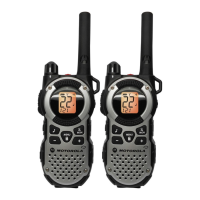


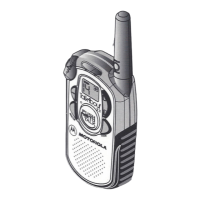




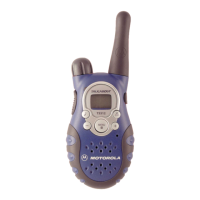
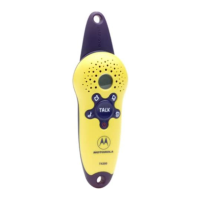

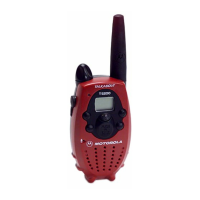
